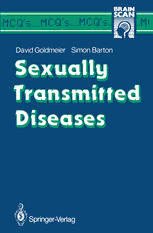
Sexually Transmitted Diseases PDF
Preview Sexually Transmitted Diseases
MI :: I:;:r -:-____ MI :: 11'-:-__ ._ M 1 ::11'-:-__ David Goldmeier . Simon Barton Sexually Transmitted Diseases Springer-Verlag London Berlin Heidelberg New York Paris Tokyo David Goldmeier, MD, MRCP, Consultant Venereologist, St Mary's Hospital, London, W2 Simon Barton, BSc, MB, BS, Research Fellow, St Mary's Hospital, London, W2 Publishers note: the 'Brainscan' logo is reproduced by courtesy of The Editor, Geriatric Medicine, Modem Medicine GB Ltd ISBN-I3: 978-3-540-17056-3 e-ISBN-13: 978-1-4471-1432-1 DOl: 10.1007/978-1-4471-1432-1 The work is subject to copyright. All rights are reserved, whether the whole or part of the material is concerned, specifically those of translation, reprinting, re-use of illustrations, broadcasting, reproduction by photocopying, machine or similar means, and storage in data banks. © Springer-Verlag Berlin Heidelberg 1987 The use of registered names, trademarks, etc. in this publication does not imply, even in the absence of a specific statement, that such names are exempt from the relevant protective laws and regulations and therefore free for general use. Product Liability: The publisher can give no guarantee for information about drug dosage and application thereof contained in this book. In every individual case the respective user must check its accuracy by consulting other pharmaceutical literature. Phototypesetting by Tradeset Photo setting, 10 Garden Court Business Centre, Tewin Road, Welwyn Garden City, Hertfordshire, AL7IBH. Printed by Page Bros. (Norwich) Limited, Mile Cross Lane, Norwich. 2128/3916-543210 Dedication To PBG and to my teachers Drs Dunlop, Rodin and Oriel (DG) To John and Edna (SEB) Preface "Conclusions are usually considered guesses" Henry S. Haskins, American writer in Meditations in Wall Street Students' minds, whether undergraduate or postgraduate, soon become stale when faced with lectures or even not so large textbooks. Supplementing lecture notes and textbooks with multiple-choice questions, therefore, attunes the mind to this style of examination which the student will certainly meet and yet also relieves the tedium and monotony of the conventional learning route. This multiple-choice textbook, therefore, should be used side by side with lecture notes, textbooks and clinical teaching material. The book covers a wide field of genitourinary medicine. This necessarily overlaps with general medicine, urology, bacteriology, virology, psychiatry, sexual medicine, im munology and proctology. With regard to immunology, a basic set of teaching questions are included so that HIV disease may be more easily understood without recourse to immunology textbooks. The answers to the questions are not given in a uniform style. This is partly to relieve monotony, and partly because some questions need no explanation, others need a prose answer and yet others are best answered by a point-by-point explanation. We also provide references for those interested. There is some overlap between questions but only enough, we hope, to facilitate learning but not produce somnolence. For the same reason, we have included a sprinkling of cartoons and poems. They all appear in close proximity to the relevant questions in the text. The poems at least are far from works of art, but are designed to make the student think about the pertinent subjects in a lighthearted way and so reinforce the learning process. The answers to some questions are really clinical opinions, e.g. how to handle frequently recurrent genital herpes. Those who disagree with these or any other answers are invited to write to the authors so that we can be persuaded by their viewpoints. The Questions and Answers contained in this book have been compiled in collaboration with Drs M. Byrne, G. Forster, S. Forster, D. Hawkiris, C. Ison, J. Parkin, L. Stacey, R. Taylor, and Miss. A. McCreaner. We should therefore, like to thank all of them for the thought, time and effort they invested in this project. Grateful thanks are due also to Dr J. R. W. Harris and Dr. A. J. Pinching for their useful comments, to Ann Persad for her typing and to our medical students who have tried out our questions. London David Goldmeier June 1986 Simon Barton Contents 1. Bacterial Vaginosis, Candidiasis and Trichomoniasis .......................................................... 2 2. Chancroid and Granuloma Inguinale ....................... 14 3. Chlamydial IJisease ...................... .................. ........... 20 4. Colposcopy and Cervical Pathology ......................... 30 5. Genital Warts ............................................................. 38 6. Gonorrhoea ....................................... ......................... 44 7. Gastrointestinal Diseases .......................................... 56 8. Hepatitis............................................................ ......... 68 9. Genital Hetpes ........................................................... 74 10. Human Immunodeficiency Virus (HIV) Related Disease and Immunology .......................................... 84 11. Pelvic Inflammatory Disease ..................................... 110 12. Prostatitis ................................... ................................ 116 13. Psychological and Sexual Problems .......................... 122 14. Syphilis ....................................................................... 128 15. Miscellaneous ............................................................. 148 16. Case Histories ............................................................ 164 References .......................................................................... 184 1. Bacterial Vaginosis, Candidiasis and Trichomoniasis Questions Q.1.1 Bacterial vaginosis is associated with increased numbers of: a. Gardnerella vagina lis b. Lactobacilli c. Mycoplasma hominis d. Beta-haemolytic streptococci e. Non-sporing anaerobes Q.1.2 'Clue' cells: a. Are epithelial cells b. Were described by Gardner and Dukes in 1959 c. Are associated with bacterial vaginosis d. Are not present in normal women e. Are covered with lactobacilli Q.1.3 Gardnerella vaginalis: a. Requires carbon dioxide for growth b. Produces diffuse beta haemolysis on human blood agar c. Is always Gram-positive d. Is only found in women e. Has been implicated in postpartum endometritis For answers see over 3 Answers A.I.I a. T b. F c. T d. F e. T Bacterial vaginosis is associated with a lack of lactobacilli but an increase in Gardnerella vaginalis, Mycoplasma hominis and non-sporing anaerobes. Beta-haemolytic streptococci are not associated with bacterial vaginosis. A.I.2 a. T b.T c. T d. F e. F 'Que' cells which are epithelial cells covered with coccobacilli were first described by Gardner and Dukes in 1959. They are present in large numbers in women with bacterial vaginosis and occur in about 40% of normal women. A.I.3 a. T b.T c. F d. F e. T Gardnerella vaginalis is a Gram-variable bacillus which pro duces diffuse beta haemolysis on human but not horse blood agar. It has been implicated as the causative agent of bacterial vaginosis and postpartum infection. It is carried in the urethra oflO% of men. 4
